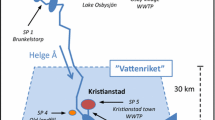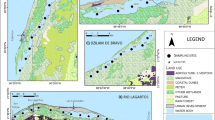Abstract
Since the discovery of trace concentrations of pharmaceuticals in streams and treated drinking water around the world, a call has been made by both the scientific community and the general public to increase understanding of the potential effects these compounds may have on freshwater integrity. We measured abundance and distribution of pharmaceuticals in headwater streams across the Upper White River Watershed of central Indiana. Four nonprescription pharmaceuticals (1,7-dimethylxanthine, caffeine metabolite; acetaminophen; caffeine; cotinine, nicotine metabolite) were found at one or more sites with mean concentrations of 0.038, 0.109, 0.057 and 0.041 μg/l, respectively. Caffeine was measured at trace concentrations at all sites sampled. Higher pharmaceutical concentrations were associated with streams having >90% agricultural land use in the sub watershed, suggesting that nonpoint sources, such as septic tanks, may contribute to stream pharmaceutical contamination. To assess the influence of these pharmaceuticals on stream microbial activity, we measured changes in sediment respiration and nutrient uptake in response to pharmaceuticals using both in vitro and in situ techniques. For in vitro experiments, respiration rates were not significantly different from controls with pharmaceutical exposure. However, net NO3 −-N uptake increased significantly with nicotine concentrations. Net NH4 +-N uptake was reduced in response to caffeine and nicotine exposure. In situ experiments indicated nicotine exposure increased microbial respiration. Our data show pharmaceuticals are ubiquitous in headwater streams of central Indiana and likely influence stream microbial activity depending on the pharmaceutical compound and history of exposure.






Similar content being viewed by others
References
Aminot A, Kirkwood DS, Kérouel R (1997) Determination of ammonia in seawater by the indophenol-blue method: evaluation of the ICES NUTS I/C 5 questionnaire. Mar Chem 56:59–75
Balser TC, McMahon KD, Bart D, Bronson D, Coyle DR, Craig N, Flores-Mangual ML, Forshay K, Jones SE, Kent AE, Shade AL (2006) Bridging the gap between micro- and macro-scale perspectives on the role of microbial communities in global change ecology. Plant Soil 298:58–70
Barber LB, Murphy SF, Verplanck PL, Sandstorm MW, Taylor HE, Furlong ET (2006) Chemical loading into surface water along a hydrological, biogeochemical, and land use gradient: a holistic watershed approach. Environ Sci Technol 40:475–486
Barnes KK, Kolpin DW, Furlong ET, Zaugg SD, Meyer MT, Barber LB (2008) A national reconnaissance of pharmaceuticals and other organic wastewater contaminants in the United States: I) groundwater. Sci Total Environ 402:192–200
Bradley PM, Barber LB, Kolpin DW, McMahon PB, Chapelle FH (2007) Biotransformation of caffeine, cotinine, and nicotine in stream sediments: implications for use as wastewater indicators. Environ Toxicol Chem 26:1116–1121
Buerge I, Poiger T, Muller MD, Buser H (2003) Caffeine, an anthropogenic marker for wastewater contamination of surface waters. Environ Sci Technol 27:691–700
Cahill JD, Furlong ET, Burkhardt MR, Kolpin DW, Anderson LG (2004) Determination of pharmaceutical compounds in surface-and ground-water samples by solid-phase extraction and high-performance liquid chromatography-electrospray ionization mass spectrometry. J Chromatogr 1041:171–180
Cain TG, Kolpin DW, Vargo JD, Wichman MD (2004) Occurrence of antibiotics, pharmaceuticals and sterols at select surface and wastewater sites in Iowa. In proceedings of the 4th international conference on pharmaceuticals and endocrine disrupting chemicals in water, Minneapolis, MN, 13–15 Oct 2004. National Ground Water Association, pp 151–157 (CD-Rom)
Clements WH (2000) Integrating effects of contaminants across levels of biological organization: an overview. J Aquat Ecosyst Stress Recovery 7:113–116
Crane M, Watts C, Boucard T (2006) Chronic aquatic environmental risk from exposure to human pharmaceuticals. Sci Total Environ 367:23–41
Crawford CG (1995) Occurrence of pesticides in the White River, Indiana, 1991–95. U.S. Geological Survey Fact Sheet, pp 233–295
Daughton CG, Ternes TA (1999) Pharmaceuticals and personal care products in the environment: agents of subtle change. Environ Health Perspect 107:906–938
Dodds WK, Welch E (2000) Establishing nutrient criteria in streams. J North Am Benthol Soc 19:186–196
Duda AM, Lenet DR, Penrose DL (1982) Water quality in urban streams—what we can expect. J Water Pollut Control Fed 54:1139–1147
Ellis JB (2006) Pharmaceutical and personal care products (PPCPs) in urban receiving waters. Environ Pollut 144:184–189
Focazio MJ, Kolpin DW, Barnes KK, Furlong ET, Meyer MT, Zaugg DS, Barber LB, Thurman ME (2008) A national reconnaissance for pharmaceuticals and other organic wastewater contaminants in the United States - II) untreated drinking water sources. Sci Total Environ 402:201–216
Glassmeyer ST, Furlong ET, Kolpin DW, Cahill JD, Zaugg SD, Werner SL, Meyer MT, Kryak DD (2005) Transport of chemical and microbial compounds from known wastewater discharges: potential for use as indicators of human fecal contamination. Environ Sci Technol 39:5157–5169
Gómez MJ, Martínez Bueno MJ, Lacorte S, Fernández-Alba AR, Agüera A (2007) Pilot survey monitoring pharmaceuticals and related compounds in a sewage treatment plant located on the Mediterranean coast. Chemosphere 66:933–1002
Hall RO, Meyer JL (1998) The trophic significance of bacteria in a detritus-based stream food web. Ecology 79:1995–2012
Halling-Sørensen B, Nielson SN, Lanzky PF, Ingerslev F, Holten-Lutzhoft J, Jorgensen SE (1998) Occurrence, fate and effects of pharmaceutical substances in the environment—a review. Chemosphere 35:357–393
Heckmann LH, Callaghan A, Hooper HL, Connon R, Hutchinson TH, Maund SL, Sibly RM (2007) Chronic toxicity of ibuprofen to Daphnia magna: effects on life history traits and population dynamics. Toxicol Lett 172:137–145
Hill BH, Hall RK, Husby P, Herlihy AT, Dunne M (2000) Interregional comparisons of sediment microbial respiration in streams. Fresh Biol 44:213–222
Inwood SE, Tank JL, Bernot MJ (2005) Patterns of denitrification associated with land use in 9 midwestern headwater streams. J North Am Benthol Soc 24:227–245
Kemp MJ, Dodds WK (2002) The influence of ammonium, nitrate, and dissolved oxygen concentrations on uptake, nitrification, and denitrification rates associated with prairie stream substrata. Limnol Oceanogr 47:1380–1393
Kolpin DW, Furlong ET, Meyer MT, Thurman EM, Zaugg SD, Barber LB, Buxton HT (2002) Pharmaceuticals, hormones, and other organic wastewater contaminants in US streams, 1999–2000: a national reconnaissance. Environ Sci Technol 36:1202–1211
Kolpin DW, Skopec M, Meyer MT, Furlong ET, Zaugg SD (2004) Urban contribution of pharmaceuticals and other organic wastewater contaminants to streams during differing flow conditions. Sci Total Environ 328:119–130
Lawrence JR, Swerhone GDW, Wassenarr LI, Neu TR (2005) Effects of selected pharmaceuticals on riverine biofilm communities. Can J Microbiol 51:655–669
Liebert CA, Barkay T, Turner RR (1991) Acclimation of aquatic microbial communities to Hg(II) and CH3Hg+ in polluted freshwater ponds. Microb Ecol 21:139–149
Lissemore L, Hao C, Yang P, Sibley PK, Mabury S, Solomon KR (2006) An exposure assessment for selected pharmaceuticals within a watershed in Southern Ontario. Chemosphere 64:717–729
Minitab, Inc. (2006). Statistical Software, version 16. Minitab, Incorporated, State College, PA
Nweke CO, Alisi CS, Okolo JC, Nwanyanwu CE (2007) Toxicity of zinc to heterotrophic bacteria from a tropical river sediment. Appl Ecol Environ Res 5:123–132
Paul MJ, Meyer JL (2001) Streams in the urban landscape. Annu Rev Ecol Syst 32:333–365
Price LH, Heninger GR (1994) Lithium in the treatment of mood disorders. New Engl J Med 331:591–598
Ribbe L, Delgado P, Salgado E, Flügel WA (2008) Nitrate pollution of surface water induced by agricultural non-point pollution in the Pocochay watershed, Chile. Desalination 226:13–20
Roberts PH, Thomas KV (2006) The occurrence of select pharmaceuticals in wastewater effluent and surface waters of the lower Tyne catchment. Sci Total Environ 356:143–153
Smith GR, Burgett AA (2005) Effects of three organic wastewater contaminants on American toad, Bufo americanus, tadpoles. Ecotoxicology 14:477–482
Smith JJ, McFeters GA (1997) Mechanisms of INT (2-(4 iodophenyl)-3-(4-nitrophenyl)-5-phenyl tetrazolium chloride and CTC (5-cyano-2,3,-ditolyl tetrazolium chloride) reduction in Escherichia coli k-12. J Microbiol Meth 29:161–175
Spain JC, Van Veld PA (1983) Adaptation of natural microbial communities to degradation of xenobiotic compounds: effects of concentration, exposure time, inoculum, and chemical structure. Appl Environ Microbiol 45:428–435
Tank JL, Bernot MJ, Rosi-Marshall EJ (2006) Nitrogen limitation, uptake, and turnover in stream ecosystems. In: Hauer FR, Lamberti GA (eds) Methods in stream ecology, 2nd edn. Academic Press, San Diego, CA
Ternes TA (1998) Occurrence of drugs in German sewage treatment plants and rivers. Water Res 32:3245–3260
Ternes TA, Meisenheimer M, McDowell D, Sacher F, Brauch H, Haist-Gulde B, Preuss G, Wilme U, Zulei-Seibert N (2002) Removal of pharmaceuticals during drinking water treatment. Environ Sci Technol 36:3855
Upper White River Watershed (UWRW) Alliance (2007) http://www.whiteriveralliance.org. Accessed 4 Oct 2007
Walsh CJ, Roy AH, Feminella JW, Cottingham PD, Groffman PM, Morgan RP (2005) The urban stream syndrome: current knowledge and the search for a cure. J North Am Benthol Soc 24:706–723
Acknowledgments
We thank USGS National Water Quality Laboratory for pharmaceutical analyses; J. Mitchell and M. Pyron for valuable discussion; N. Bunch, E. Martin, M. Brandenburg, and A. Balakrishnan for assistance with sample collection and analyses. This study was funded with Lily V monies awarded to M. Bernot, Ball State Graduate Student Research Grant and Indiana Academy of Science senior research grant awarded to A. Bunch and M. Bernot.
Author information
Authors and Affiliations
Corresponding author
Rights and permissions
About this article
Cite this article
Bunch, A.R., Bernot, M.J. Distribution of nonprescription pharmaceuticals in central Indiana streams and effects on sediment microbial activity. Ecotoxicology 20, 97–109 (2011). https://doi.org/10.1007/s10646-010-0560-6
Accepted:
Published:
Issue Date:
DOI: https://doi.org/10.1007/s10646-010-0560-6




